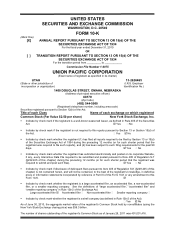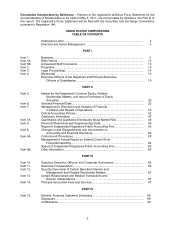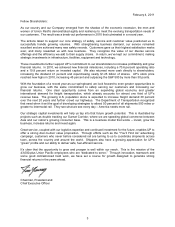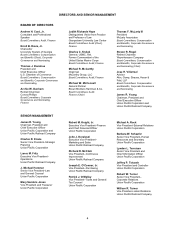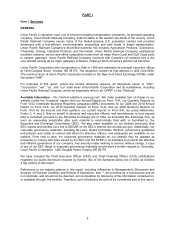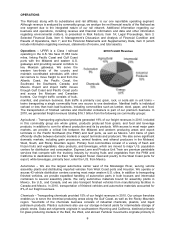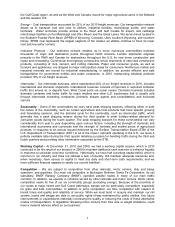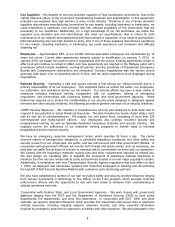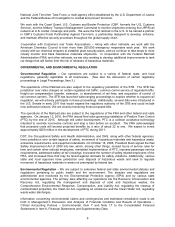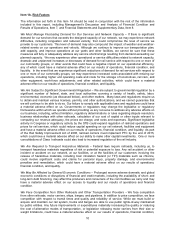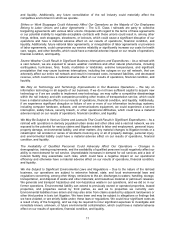Union Pacific 2010 Annual Report Download - page 9
Download and view the complete annual report
Please find page 9 of the 2010 Union Pacific annual report below. You can navigate through the pages in the report by either clicking on the pages listed below, or by using the keyword search tool below to find specific information within the annual report.9
National Joint Terrorism Task Force, a multi-agency effort established by the U.S. Department of Justice
and the Federal Bureau of Investigation to combat and prevent terrorism.
We work with the Coast Guard, U.S. Customs and Border Protection (CBP, formerly the U.S. Customs
Service), and the Military Transport Management Command to monitor shipments entering the UPRR rail
network at U.S. border crossings and ports. We were the first railroad in the U.S. to be named a partner
in CBP’s Customs-Trade Partnership Against Terrorism, a partnership designed to develop, enhance,
and maintain effective security processes throughout the global supply chain.
Cooperation with Customers and Trade Associations – Along with other railroads, we work with the
American Chemistry Council to train more than 200,000 emergency responders each year. We work
closely with our chemical shippers to establish plant security plans, and we continue to take steps to more
closely monitor and track hazardous materials shipments. In cooperation with the Federal Railroad
Administration (FRA) and other railroads, we are also working to develop additional improvements to tank
car design that will further limit the risk of releases of hazardous materials.
GOVERNMENTAL AND ENVIRONMENTAL REGULATION
Governmental Regulation – Our operations are subject to a variety of federal, state, and local
regulations, generally applicable to all businesses. (See also the discussion of certain regulatory
proceedings in Legal Proceedings, Item 3.)
The operations of the Railroad are also subject to the regulatory jurisdiction of the STB. The STB has
jurisdiction over rates charged on certain regulated rail traffic; common carrier service of regulated traffic;
freight car compensation; transfer, extension, or abandonment of rail lines; and acquisition of control of
rail common carriers. The STB has launched wide-ranging proceedings to explore whether to expand rail
regulation; we will actively participate in these proceedings. Additionally, several bills were introduced in
the U.S. Senate in early 2011 that would expand the regulatory authority of the STB and could include
new antitrust provisions. We are closely monitoring these proposed bills.
The operations of the Railroad also are subject to the regulations of the FRA and other federal and state
agencies. On January 12, 2010, the FRA issued final rules governing installation of Positive Train Control
(PTC) by the end of 2015. Although still under development, PTC is a collision avoidance technology
intended to override locomotive controls and stop a train before an accident. The FRA acknowledged
that projected costs will exceed projected benefits by a ratio of about 22 to one. We expect to invest
approximately $250 million in the development of PTC during 2011.
DOT, the Occupational Safety and Health Administration, and DHS, along with other federal agencies,
have jurisdiction over certain aspects of safety, movement of hazardous materials and hazardous waste,
emissions requirements, and equipment standards. On October 16, 2008, President Bush signed the Rail
Safety Improvement Act of 2008 into law, which, among other things, revised hours of service rules for
train and certain other railroad employees, mandated implementation of PTC, imposed passenger service
requirements, addressed safety at rail crossings, increased the number of safety related employees of the
FRA, and increased fines that may be levied against railroads for safety violations. Additionally, various
state and local agencies have jurisdiction over disposal of hazardous waste and seek to regulate
movement of hazardous materials in areas not preempted by federal law.
Environmental Regulation – We are subject to extensive federal and state environmental statutes and
regulations pertaining to public health and the environment. The statutes and regulations are
administered and monitored by the Environmental Protection Agency (EPA) and by various state
environmental agencies. The primary laws affecting our operations are the Resource Conservation and
Recovery Act, regulating the management and disposal of solid and hazardous wastes; the
Comprehensive Environmental Response, Compensation, and Liability Act, regulating the cleanup of
contaminated properties; the Clean Air Act, regulating air emissions; and the Clean Water Act, regulating
waste water discharges.
Information concerning environmental claims and contingencies and estimated remediation costs is set
forth in Management’s Discussion and Analysis of Financial Condition and Results of Operations –
Critical Accounting Policies – Environmental, Item 7 and Note 17 to the Consolidated Financial
Statements in Item 8, Financial Statements and Supplementary Data.

